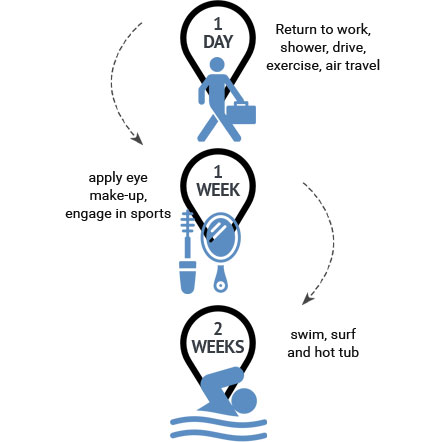“There was nothing I hated more than my contact lenses — except maybe Seattle! —
which is why I’m now lovin’ my LASIK vision, thanks to Dr. Hyver!”
“All Laser” LASIK patient and
all-pro football left tackle, Joe Staley

“All Laser” LASIK is one of the world’s most popular laser vision correction procedures for the treatment of nearsightedness and astigmatism. The goal of “All Laser” LASIK is to help patients see equal to or better than their contact lenses and glasses and, through the use of Wavefront-Optimized techniques, to help preserve or even improve their vision quality, especially their night vision.

“All Laser” LASIK is a two-step procedure. In the first step, Dr. Hyver employs our Ziemer Z-Series femtosecond laser to create a corneal flap, which he then lifts, exposing the underlying tissue. In the 2nd step, he applies the Alcon EX500 wavefront-optimized excimer laser to the exposed tissue to correct the patient’s nearsightedness and astigmatism, after which he restores the flap whereupon it heals, preserving the new vision.
Unlike older systems that use a surgical blade, “All Laser” LASIK employs lasers in both steps of the LASIK procedure, giving Dr. Hyver far greater control over the treatment process and eliminating the unique risks of the older technology.
Note that at the start of the following video, the split frame on the left shows the surgical blade approach to creating the corneal flap (i.e., the “microkeratome”), while the frame on the right shows the newer femtosecond laser approach that Dr. Hyver employs to create the flap:

The Wavefront-Optimized “All Laser” LASIK procedure is also customized to your prescription and to your corneal curvature. Using proprietary Wavefront-Optimized software algorithms, the Alcon EX500 excimer laser adjusts its energy delivery on the periphery of the treatment zone in order to help achieve a natural prolate corneal shape, which can help minimize spherical aberration and therefore contribute to better night vision quality.


During the first four hours after your LASIK procedure, your vision will be hazy (similar to looking through a film), and you’re likely to experience varying degrees of eye stinging, scratchiness, tearing, and light sensitivity.
One day after surgery, aside from a little dryness, your eyes should feel relatively normal, and your vision should be clear enough to resume most of your normal lifestyle. However, results vary from patient-to-patient, based on the patient’s preoperative prescription and the type of work he or she performs.
Over the next few weeks, your vision should gradually sharpen to reach its best correction.
With today’s state-of-the-art laser infrastructure, combined with Dr. Hyver’s experience and deep surgical database, it’s rare that our “All Laser” LASIK patients don’t see 20/20 or better. Like any medical procedure, however, LASIK is not without risks or alternatives. Learn more about LASIK in our FAQ and about LASIK safety here.
LASIK is an elective medical procedure designed to correct the patient’s nearsightedness and astigmatism by reshaping the patient’s cornea using a laser. In the “All Laser” LASIK procedure, a femtosecond laser is employed to create a corneal flap, which is then lifted, after which the underlying tissue is reshaped with a different excimer laser, and then the flap is repositioned in place, whereupon the cornea heals preserving the new vision.
Dr. Hyver will determine if you are medically-qualified for LASIK based on a review of your diagnostic test results, including your prescription, corneal shape and thickness, baseline tear function, pupil size, and general overall eye health. If these criteria meet Dr. Hyver’s approval threshold, he’ll approve you for LASIK; otherwise, he’ll either approve you for a different form of laser vision correction, such as PRK, or not medically approve you for any form of treatment.
The LASIK procedure takes about five minutes per eye. While lying on your back, your eyes are numbed with special eye drops, after which one eye will be held open with a small eyelid holder. This eye will then be held in position for about 30 seconds during which you’ll feel a pressure sensation on the eye. Following this, the laser will treat the eye for approximately 5 to 10 seconds as you stare at a blinking fixation light. You will not see or feel the laser. After the laser completes its work, the eyelid holder is removed and you’re free to blink. The same steps apply if your other eye is treated.
You don’t have to worry about blinking because your eyelids will be held securely open with the eyelid holder. Also, because your eye is numb, you won’t typically feel the need to blink. Most advanced LASIK laser systems are designed to automatically compensate for any involuntary or inadvertent movements of your eye or body during treatment.
Most patients experience little to no discomfort during treatment. Discomfort, if any, occurs primarily when your eye is held in position with the eyelid holders, creating a pressure sensation on the eye. Following this, you’ll feel very little sensation.
Someone will need to take you home after the procedure. Your vision will be hazy and your eyes will experience some stinging for the first few hours. You should rest during this time. Most LASIK patients can resume driving and working the next day, including extended use of computer displays, which should not affect your recovery or final visual outcome.
You’ll need to apply prescription eye drops for a prescribed period following your LASIK procedure. You’ll also need to wear protective goggles when you sleep, typically for the first week following your treatment. Most patients can resume their normal lifestyle the day after their LASIK procedure, including showering, driving, working, being out in the sun, exercising, and air travel. However, you should not swim for at least the first two weeks following treatment.
As long as your prescription is stable, you can expect your visual outcome to last for many years. If your vision does decline, however, the change is likely to be relatively small compared to your original prescription, and it’s something that can most likely be addressed through an enhancement procedure.
Experiencing glare around lights at nighttime — including starbursts, ghosting and halos — is fairly common early in the LASIK recovery process, but these effects shouldn’t prevent you from driving at night. The effects gradually lessen and, in the majority of patients, fully resolve within three to six months following surgery. A small percentage of patients, however, will continue to experience some degree of night disturbance indefinitely, but the effects are typically mild.
It’s fairly common to experience dry eye sensation early in the LASIK recovery process, especially upon awakening in the morning. Artificial tear drops may be used for relief. The dry eye sensation is generally mild and gradually resolves within three to six months following surgery. For a small percentage of patients, some degree of dry eye sensation may persist indefinitely, but the effects are typically mild.
